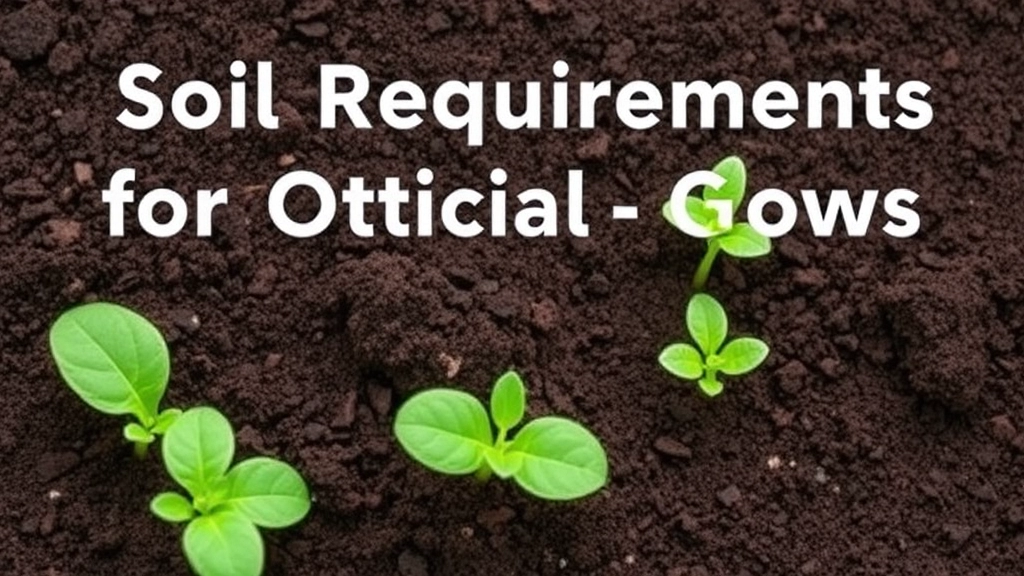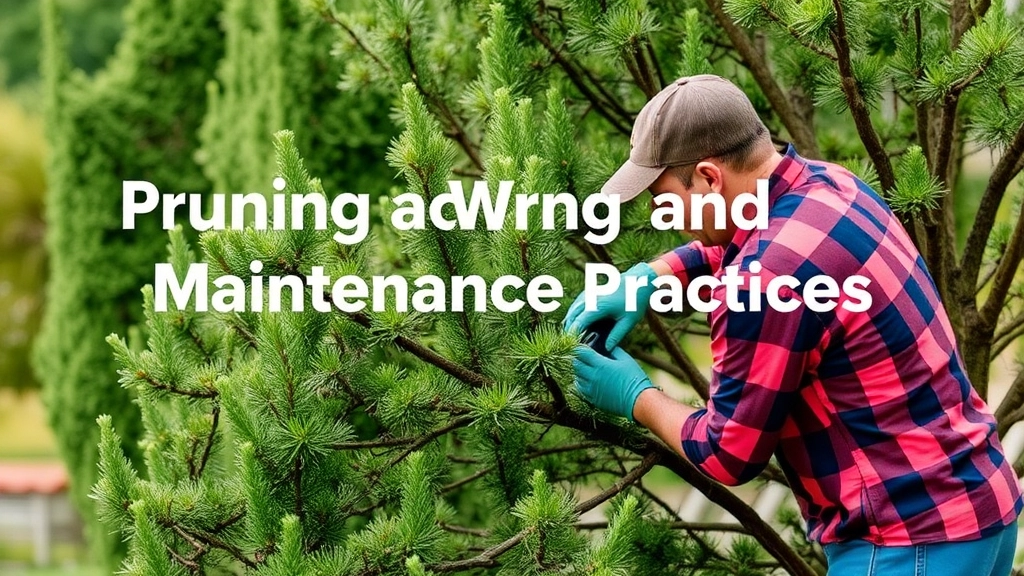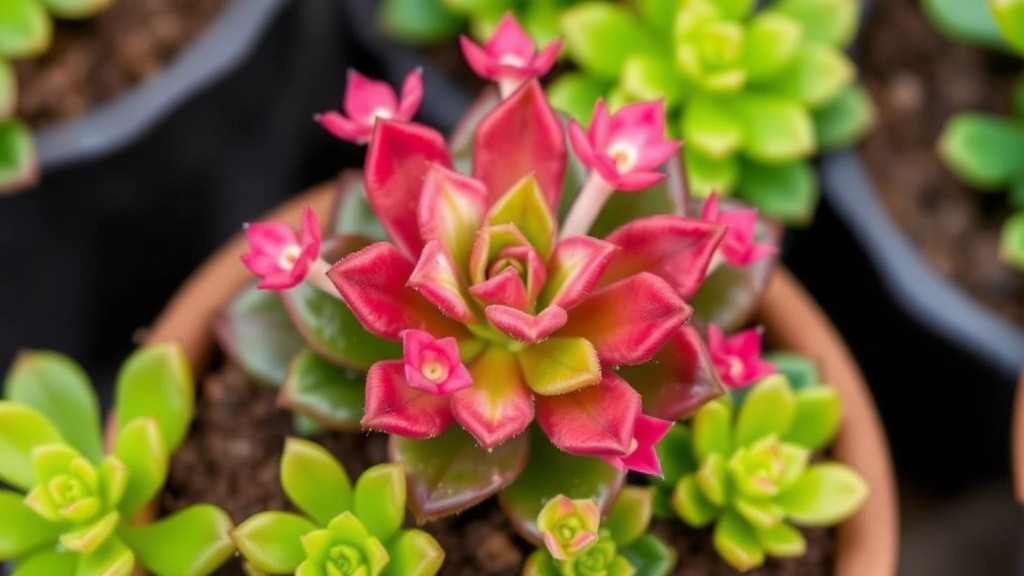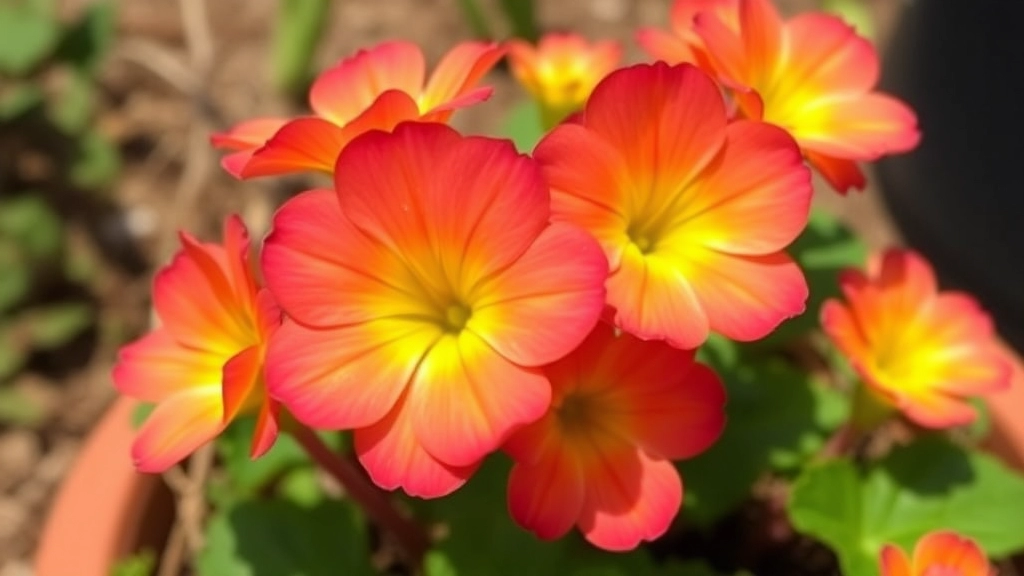Growing Kalanchoe Outdoors
Growing Kalanchoe outdoors can be a rewarding experience if you know the right steps. This succulent, known for its vibrant flowers and low maintenance, thrives in specific conditions. In this guide, I’ll walk you through the essentials to ensure your Kalanchoe flourishes in your garden.
From choosing the perfect spot with ample sunlight to understanding the watering needs, we’ll cover everything you need to get started. Whether you’re a seasoned gardener or a newbie, these practical tips will help you make the most of growing Kalanchoe outdoors.
Choosing the Right Location for Kalanchoe
Are you struggling to find the perfect spot for your Kalanchoe? You’re not alone. Many plant enthusiasts face this dilemma, as the right location can significantly impact the health and growth of your succulent.
Kalanchoe thrives in environments that mimic its natural habitat. Here are some key considerations when selecting a location:
- Light Exposure: Kalanchoe prefers bright, indirect sunlight. A south-facing window is often ideal, but be cautious of harsh midday sun, which can scorch the leaves. For more detailed light requirements, you can refer to this Mother of Thousands care guide.
- Temperature: These plants enjoy warmth, ideally between 20°C to 25°C during the day. Avoid placing them in drafty areas or near heating vents.
- Humidity: Kalanchoe does well in low to moderate humidity. If your home is particularly humid, ensure good air circulation to prevent rot.
- Accessibility: Choose a spot where you can easily care for your plant. Regular checks for watering and maintenance are essential for optimal growth. For a comprehensive guide on Kalanchoe care, visit this ultimate care guide.
- Safety from Pests: Avoid areas where pests are common, such as near open windows or doors. Keeping your Kalanchoe in a less trafficked area can help reduce the risk of infestations.
Soil Requirements for Optimal Growth

So, you’ve got your Kalanchoe all set up in a nice spot, but have you thought about the soil?
Choosing the right soil is crucial for your plant’s health.
Here’s what you need to know:
- Well-Draining Soil: Kalanchoe loves to breathe. A mix that drains well prevents root rot. Look for potting soil specifically designed for succulents or cacti.
- pH Level: Aim for a slightly acidic to neutral pH, around 6.0 to 7.0. This range helps your Kalanchoe absorb nutrients effectively.
- Additives: You can mix in perlite or coarse sand. This not only improves drainage but also aerates the soil, making it easier for roots to grow.
- Nutrient-Rich: While Kalanchoe doesn’t require overly rich soil, a little organic matter can help. Think about adding some compost to give your plant a nutrient boost.
- Pot Choice: Make sure your pot has drainage holes. This is a game-changer for preventing water from sitting at the bottom.
Watering Schedule and Techniques
When it comes to caring for your Kalanchoe, watering is often a source of confusion.
How often should I water my Kalanchoe?
Kalanchoe, a succulent plant, thrives on a specific watering schedule that balances moisture and dryness. Overwatering can lead to root rot, while underwatering can cause the leaves to shrivel.
Sunlight and Temperature Needs

When it comes to nurturing Kalanchoe, many enthusiasts often wonder about the ideal sunlight and temperature conditions for optimal growth.
Sunlight Requirements
Kalanchoe thrives in bright, indirect sunlight.
- Direct Sunlight: While Kalanchoe can tolerate some direct sunlight, too much can scorch the leaves. Aim for around 6 hours of indirect sunlight daily.
- Indoor Placement: A south or west-facing window is perfect for indoor plants. If the leaves start to look pale or leggy, they may need more light.
- Outdoor Conditions: If you’re growing Kalanchoe outside, partial shade during the hottest part of the day can help prevent leaf burn.
Temperature Preferences
Temperature plays a crucial role in the health of your Kalanchoe.
- Ideal Range: Kalanchoe prefers temperatures between 15°C and 25°C (59°F to 77°F).
- Cold Sensitivity: Be cautious of temperatures below 10°C (50°F), as Kalanchoe is sensitive to frost.
- Heat Tolerance: While it can handle warmer conditions, ensure proper ventilation to prevent overheating.
Practical Tips
- Monitor Conditions: Keep an eye on your plant and adjust its placement as needed.
- Seasonal Changes: During colder months, consider moving your Kalanchoe indoors or providing extra warmth.
Fertilizing Tips for Healthy Kalanchoe Plants
After ensuring your Kalanchoe is in the right location and has suitable soil, the next crucial step is fertilization. Many plant owners often wonder how to keep their Kalanchoe thriving and vibrant.
Understanding Fertilization Needs
Kalanchoe plants are not heavy feeders, but they do benefit from the right nutrients. Here are some straightforward tips for fertilizing your Kalanchoe effectively:
- Type of Fertilizer: Opt for a balanced, water-soluble fertiliser with an N-P-K ratio of 10-10-10 or 20-20-20. This ensures your plant receives essential nutrients without overwhelming it.
- Frequency: Fertilize every 4-6 weeks during the growing season (spring and summer). Skip fertilization in the fall and winter when the plant is dormant.
- Dilution: Always dilute the fertiliser to half the recommended strength to prevent root burn.
- Application: Apply the fertiliser to moist soil. This helps the nutrients absorb better and reduces the risk of damaging the roots.
Signs of Nutrient Deficiency
It’s essential to watch for signs that your Kalanchoe may need more nutrients:
Pruning and Maintenance Practices

So, you’ve got your Kalanchoe thriving, but how do you keep it looking its best?
Pruning is key to maintaining a healthy plant and encouraging vibrant growth.
Why Prune?
- Promotes Airflow: Cutting back overcrowded stems helps prevent diseases.
- Encourages New Growth: Snipping off dead or wilted leaves can stimulate fresh blooms.
- Shapes the Plant: A little pruning here and there can keep your Kalanchoe looking tidy and well-formed.
When to Prune?
- After Blooming: The best time to prune is right after the flowering period.
- Regular Check-ins: Keep an eye on your plant every few weeks to catch any dead leaves or stems.
How to Prune?
- Gather Your Tools: A clean pair of scissors or pruning shears works wonders.
- Identify the Dead Parts: Look for wilted leaves or stems that are turning brown.
- Make Clean Cuts: Snip just above a leaf node to encourage new growth.
- Dispose of Debris: Clear away any cuttings to keep the area tidy and disease-free.
Maintenance Tips
- Dust Off Leaves: Occasionally wipe leaves with a damp cloth to keep them clean and allow for better light absorption.
- Rotate Your Plant: Give it a gentle spin every now and then to ensure even growth.
- Check for Pests: Regularly inspect for any unwanted visitors that might be hiding in the leaves.
Common Pests and Diseases
As we delve deeper into caring for Kalanchoe, it’s essential to address a concern many plant enthusiasts face: pests and diseases.
Identifying Common Pests
Kalanchoe plants, while resilient, can fall prey to a few common pests. Here’s a quick rundown:
- Aphids: These tiny insects suck the sap from the leaves, leading to yellowing and stunted growth.
- Mealybugs: Look for cotton-like clusters on stems and leaves. They can cause significant damage if left unchecked.
- Spider Mites: Fine webbing on the underside of leaves is a telltale sign. They thrive in dry conditions.
- Scale Insects: These appear as small bumps on the stems and leaves, often leading to leaf drop.
Diseases to Watch For
In addition to pests, Kalanchoe can also suffer from diseases. Here are the most common:
- Leaf Spot: Caused by overwatering, this disease manifests as dark spots on leaves.
- Root Rot: A consequence of poor drainage, root rot can quickly kill your plant if not addressed.
Prevention and Treatment
Keeping your Kalanchoe healthy requires vigilance. Here are some tips:
- Regular Inspections: Check your plants weekly for any signs of pests or disease.
- Proper Watering: Ensure you’re not overwatering, as this can lead to root rot and other issues.
- Use Insecticidal Soap: For pest infestations, a gentle spray of insecticidal soap can be effective.
- Remove Affected Leaves: If you spot disease, prune away the affected areas to prevent spread.
By being proactive, you can keep your Kalanchoe thriving and free from unwanted visitors. For more detailed advice on specific varieties, check out our Kalanchoe Beharensis care guide and our tips on why Kalanchoe flowers turn brown.
Propagation Methods for Kalanchoe

So, you’re loving your Kalanchoe and thinking, “How can I get more of these beauties?”
Great question!
Propagation is a fantastic way to expand your plant family without breaking the bank.
Here’s how you can easily propagate Kalanchoe:
1. Leaf Cuttings
- Choose a Healthy Leaf: Pick a plump, healthy leaf from the parent plant.
- Cut It Off: Use a clean, sharp knife to cut the leaf.
- Let It Callus: Place the leaf in a dry spot for a few days until the cut end forms a callus.
- Plant It: Stick the callused end into well-draining soil. Water lightly.
2. Stem Cuttings
- Select a Stem: Look for a healthy stem with a few leaves.
- Cut the Stem: Snip it about 3-4 inches long.
- Callus Time: Allow the cut end to dry for a few days.
- Plant: Insert the cut end into soil and water sparingly.
3. Offsets
- Identify Offsets: These are little plantlets that grow around the base of the parent plant.
- Gently Remove: Carefully twist or cut them away from the main plant.
- Replant: Place them in their own pot with proper soil.
4. Leaf Propagation in Water
- Leaf in Water: You can also place a leaf in a jar of water.
- Wait for Roots: Change the water regularly and wait for roots to form.
- Transfer to Soil: Once roots are a few inches long, transfer to soil.
Propagation can be a rewarding experience, and before you know it, you’ll have a whole collection of Kalanchoe plants to brighten up your space or share with friends!
Seasonal Care and Protection for Kalanchoe
As we transition through the seasons, the care for your Kalanchoe needs to adapt to changing conditions. Many plant enthusiasts often worry about how to keep their beloved succulents thriving throughout the year.
FAQs on Growing Kalanchoe Outdoors
What type of soil is best for Kalanchoe?
Kalanchoe thrives in well-draining soil. A mix specifically designed for succulents or cacti is ideal. You can also add perlite or coarse sand to improve drainage and aeration.
What pH level should the soil have for Kalanchoe?
A slightly acidic to neutral pH, around 6.0 to 7.0, is optimal for Kalanchoe. This range helps the plant absorb nutrients effectively.
How much sunlight does Kalanchoe need?
Kalanchoe prefers bright, indirect sunlight. It can tolerate some direct sunlight but too much can scorch the leaves. Aim for around 6 hours of indirect sunlight daily.
Can Kalanchoe handle cold temperatures?
Kalanchoe is sensitive to frost and prefers temperatures between 15°C and 25°C (59°F to 77°F). Be cautious of temperatures below 10°C (50°F).
How do I prune my Kalanchoe?
Pruning is essential for maintaining a healthy Kalanchoe. Use a clean pair of scissors or pruning shears to snip off dead or wilted leaves and stems. This promotes airflow and encourages new growth.
When is the best time to prune Kalanchoe?
The best time to prune is right after the flowering period. Regularly check your plant every few weeks to remove any dead leaves or stems.
What are some common propagation methods for Kalanchoe?
Common propagation methods include leaf cuttings, stem cuttings, offsets, and leaf propagation in water. Each method involves letting the cut end callus before planting it in well-draining soil.
How do I propagate Kalanchoe using leaf cuttings?
Choose a healthy leaf, cut it off with a clean knife, let it callus for a few days, and then plant the callused end into well-draining soil. Water lightly.
Can I propagate Kalanchoe in water?
Yes, you can place a leaf in a jar of water. Change the water regularly and wait for roots to form. Once the roots are a few inches long, transfer the leaf to soil.
What should I do if my Kalanchoe starts to look pale or leggy?
If your Kalanchoe looks pale or leggy, it may need more light. Move it to a brighter location, preferably near a south or west-facing window if indoors.
How do I prevent pests on my Kalanchoe?
Regularly inspect your plant for pests and wipe the leaves with a damp cloth to keep them clean. Ensuring proper airflow and avoiding overwatering can also help prevent pest infestations.
What are the benefits of adding organic matter to the soil?
While Kalanchoe doesn’t require overly rich soil, adding a little organic matter like compost can provide a nutrient boost and promote healthier growth.
How do I ensure proper drainage for my Kalanchoe?
Make sure your pot has drainage holes to prevent water from sitting at the bottom. Using well-draining soil and adding perlite or coarse sand can also help improve drainage.
References
-
How to Grow Kalanchoe Succulents Indoors – The Spruce
-
Kalanchoe Plant Care â Gardening Know How
-
Kalanchoe: How to Grow and Care for Kalanchoe Plants – The Old Farmer’s Almanac
